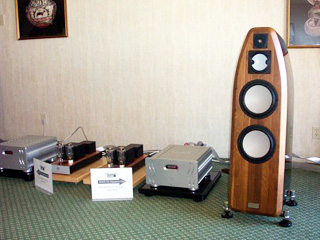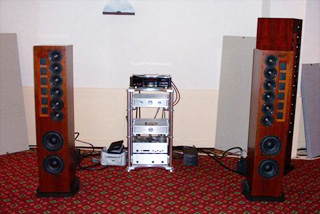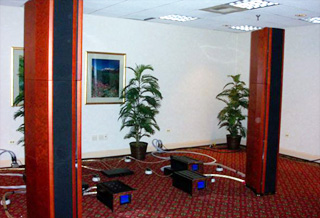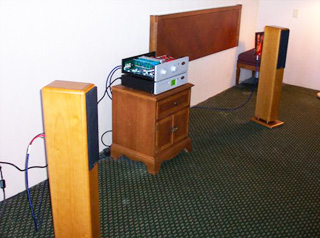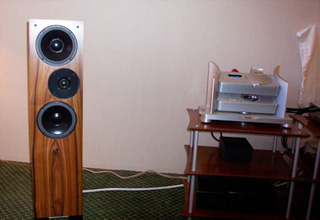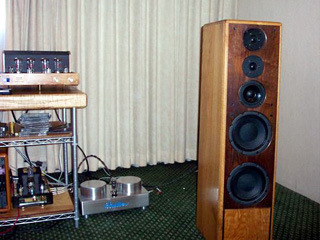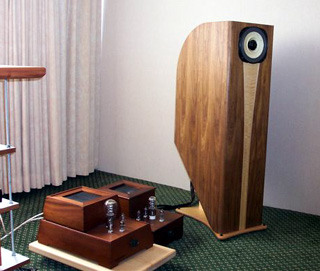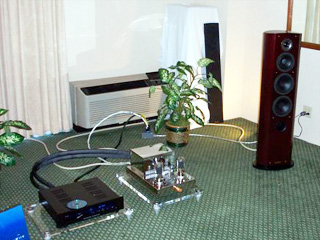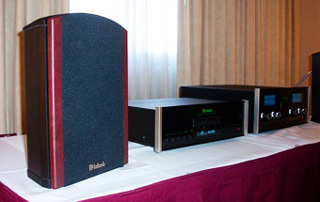 |
||||||
| October 15, 2004 Searching for the Extreme: Rocky Mountain Audio Fest The cost of exhibiting at a major audio/video show imposes quite a financial burden on smaller audio companies, so it’s natural that smaller regional shows would be created to offer a more relaxed and affordable venue for displaying the latest wares from these companies. The Rocky Mountain Audio Fest, nestled against the snow-capped Rocky Mountains in Denver, Colorado, is such a show. Organized by Ron Welborne of Welborne Labs and the Colorado Audio Society, it capitalizes on the presence of numerous audio companies in Colorado. News of the reasonable exhibitor costs spread, and several companies from outside Colorado and neighboring states took advantage of the opportunity to display their products to interested audiophiles. Over 70 rooms were used to demonstrate a variety of audio merchandise, with several manufacturers and dealers sharing rooms at the Denver Marriott Tech Center. At any show, there are a lot of products to see. Some of them sound great, while others battle adverse show conditions that include poor room acoustics and noise spilling over from neighboring exhibits. I tried to visit every exhibit, but it’s a statistical certainty that I overlooked some very interesting products. Here, however, are some of the products and systems that stood out for me.
The Audio Federation, a store in Boulder, Colorado, had one of the best-sounding systems at the Fest. In fact, it was one of the best-sounding systems I have ever heard anywhere. It featured Marten Design Coltrane speakers ($50,000/pair), Edge Electronics NL Signature One amplifiers ($31,000/pair), a Lamm L2 Reference preamp ($14,390), and either an Ensemble Dirondo transport ($7999) with an Audio Note 4.1x Balanced DAC ($12,225) or an EMM Labs CDSD transport ($7000) and EMM Labs DCC2 DAC ($10,000) spinning discs, all connected by Nordost Valhalla cables. The sound was both musically riveting and exceedingly impressive from a hi-fi viewpoint, quite an accomplishment. Another standout system featured Sonus Faber Stradivarius Homage speakers. The $39,995 flagship of Sonus Faber’s line sang beautifully in a system with Musical Fidelity’s kW500 500Wpc integrated amplifier ($6999) and Esoteric X-01 CD/SACD player ($13,000). One of the few speakers able to re-create realistic orchestral weight, the Stradivarius Homage was sensational playing vocal recordings, from opera to club music. And, of course, like all Sonus Faber speakers, the Stradivarius Homage is drop-dead gorgeous. David Ellington and Bill Peugh of Sumiko, Sonus Faber’s importer, provided one of the most thoughtful presentations I experienced in any room at the Fest. Kudos for their musical selections, which avoided the generally wretched material heard in other rooms. A new acquaintance was Vivaldi Audio, a small company that manufactures a speaker kit that uses an unusual rear-loaded horn driven by either one or two Lowther EX-3 drivers to produce a sound that had me riveted to my chair. Using Bottlehead electronics and vinyl as the source, proprietor Lew Hardy cued up the LP version of Eva Cassidy’s Songbird, and I couldn’t force myself to leave until the last cut, "Over the Rainbow," had finished. The Vivaldi Audio horn kits begin with a single-driver version at $2200 and go up to $6000 for a finished and painted dual-driver version.
In the Epiphany Audio/Edge Electronics room, I had a pleasant chat with Epiphany speaker designer Ken Gates, who described his design goal of creating high-value speakers (even though they are also fairly pricey) that are easy to drive and sound spectacular. All Epiphany speakers are of high sensitivity (from 93dB to 96dB) and studiously avoid biamping capabilities. Driven by an Edge Electronics G1 preamp ($2195) and G8 amplifier ($5995), the Epiphany 6-6+ speakers ($10,900/pair) had a very detailed yet natural sound and could handle large dynamic swings without distortion, even in the very large room. At the other end of the Epiphany room was a huge home-theater setup, with 20-21 speakers ($26,900/pair) flanking a large screen, 12-12 speakers ($14,900/pair) used for the rear channels, and a single seven-and-half-foot-tall 20-21 speaker on its side serving as the largest center-channel speaker I’ve ever seen -- it was wider than the screen! Bass was reinforced by two Epiphany E-Cube subwoofers. Adjacent to the Epiphany exhibit was a room featuring products from Colorado Springs store Audio Limits. Occupying pride of place were the huge Dali Megaline speakers ($40,000/pair), which use a 7 1/2' ribbon tweeter and an equally long array of 6 1/2" cone drivers, all in a handsome wood cabinet. Benefiting from an unusually large room, the Megalines were placed nine feet from the front wall, which enabled them to create the most realistic soundstage (actually, the only realistic soundstage) I have ever heard from an audio system. The far-from-the-wall placement probably reduced the speakers' bass performance slightly, but it was still excellent. Above the bass range, the sonic presentation was impeccable: detailed, extended, timbrally realistic, and effortlessly dynamic. The Megalines created the uncanny effect of a group of musicians sitting in front of me with no obvious connection to the speakers. Of course, the superb supporting equipment enabled the Megalines to perform so well: CED TL1-X CD transport driving an Audio Note 4.1x Balanced DAC, a Tom Evans Vibe Pulse line-stage preamp ($8600), Oasis Statement amplifiers ($12,500 per mono pair), all strung together with $65,000 of Silversmith Palladium cables. Aural Symphonics provided the power cords.
During my stop at VMAX Services’ room, proprietor Richard Kohlruss showed me two systems that provided excellent performance at reasonable prices. The first system used a Unison Research integrated amp, the new 140Wpc Unico SE ($2599 including MC/MM phono board) that uses a hybrid circuit with a tubed front-end with solid-state output. A Unico CD player ($1999) was the music source for the system, and has the unusual feature of providing a digital input as well as digital and line-level balanced and unbalanced outputs. But the star of the system was the amazing SuperPavarotti speaker from Opera. The elegant solid-hardwood enclosures are tiny: 5 1/2" wide by 8 1/2" deep by 40" tall. A 2.5-way system with only 4 1/3" midrange/bass drivers, the SuperPavarotti produced a hugely dynamic presentation with deep bass that had me searching for a hidden subwoofer (which didn’t exist). Although its specifications say bass extends to only 50Hz, in the demonstration room, the SuperPavarotti sounded as though it was reaching the upper-30Hz range. And if you want more bass, Opera offers several subwoofers. VMAX’s other high-value system was based on Audio Analogue electronics and Triangle speakers. Audio Analogue’s Paganini CD player ($1899) was the source, while the latest iteration of Audio Analogue's Puccini integrated amplifier ($1899 with phono section) provided power. Triangle Antal ES speakers ($1999/pair) generated lively, very dynamic, articulate sound with surprisingly deep bass. With a 91dB efficiency, the Antal ES speakers were completely comfortable with the 70Wpc output of the Puccini integrated amp. Glorious sound at a reasonable price!
Another system that provided exquisite sound was displayed in the Hi-Fi Logic room, where proprietor Mike Roberts, assisted by Bluebird Music’s Jay Rein, demonstrated a system built around the delightful Living Voice OBX-R II speakers ($8295/pair). Having read the string of spectacular reviews of these speakers, I was eager to hear them in person, and they did not disappoint. Delicate, detailed, dynamic and diminutive, these are speakers that could fit into a real-world room, and their fine-furniture finish would grace the most elegant home. Supporting the OBX-R IIs were a Chord BLU CD transport ($7495) driving a Chord Dac-64 DAC ($3495), and a Croft Absolute 1 preamp ($9795) driving a Croft 40Wpc Twinstar III amplifier ($7795), all connected by Chord cables. Usher Audio and Rogue Audio shared a room, which allowed me to experience the excellent Usher speakers driven by both tube amplification (Rogue) and solid-state amplification (Usher). Both configurations sounded great, with Rogue power creating a midrange to die for (without slighting the rest of the frequency spectrum), and Usher producing the bone-crushing bass. I listened to both the Usher CP-8571 speaker ($5950/pair), in an elegant, fine-furniture dark-walnut veneer, and the Usher CP-6361 ($3400/pair) in a gloss-silver finish with birch trim. The former speaker exhibited an extra degree of refinement and power befitting its higher price, but the latter wasn’t far behind, and at its price level it is one of the best speaker values I know of. A Cary CD-308-T CD player served as the source, while Rogue electronics consisted of an M-99 preamp ($2495 for the line-stage version and $2895 with a phono section) and mono M-150 amplifiers ($3995/pair). Usher’s own electronics consisted of a P307 preamp ($1980) and 150Wpc stereo amplifier ($2200). Usher Rapport cables were used throughout the system.
Daedalus Audio showed the Dynamic Audio One (DA-1) speaker ($6400/pair). A very dynamic, smooth performer whose 96dB sensitivity makes them suitable for use with lower-power amplifiers, the DA-1s can be used for music or home theater. The speaker is constructed from renewable solid hardwoods, using a dovetail process to lock panels together and extensive internal bracing to minimize resonance. Bass was extended but detailed. A very listenable sound that should prove non-fatiguing for long-term listening. As a horn-speaker enthusiast, I was very impressed by one of the most attractive horn designs I’ve seen in quite a while -- the Ocean Acoustics Horn Speaker. The Horn Speaker seemed to produce a lot of bass from the Lowther DX-4 driver used in the show model, and its dazzling cabinet design would fit well into the finest homes. The cabinet alone sells for $3000/pair; the drivers are extra. KR Audio makes some of the most interesting audio tubes on the planet, so I had to stop in the AYDN room to see the latest samples, along with KR Audio electronics. Prominently displayed were the Kronzilla DM monoblock amplifiers ($22,000/pair), which use parallel pairs of the gigantic T1610 tubes to produce 42 watts of SET power. Much closer to my budget, however, was a new line of front-end tube electronics from Artemis Labs. These included two phono preamps: the 70dB gain PL-1 ($3350) for moving-coil cartridges and the PH-1 ($2700) for moving-magnet or equivalent cartridges. The LA-1 preamp ($2850) rounds out the Artemis Labs lineup. Artemis Labs calls a feature unique to all its models Cool-Swap. Many popular preamp tubes have two triode sections, which means they can actually function as two independent gain stages. Artemis Labs uses only one of the two sections in its circuits. When the tube starts to show signs of wearing out, you can swap the two similar tubes in the circuit and use the other half of the dual triode. If you’ve bought any exotic NOS tubes lately, you’ll instantly see how this feature can help preserve your valuable audio investment. The Artemis Audio equipment, which is made in the USA, uses excellent parts and is housed in attractively retro silver cabinets. I don’t know anyone who is more dedicated to the pursuit of audio than Joe Fratus, proprietor of Art Audio USA. As an Art Audio amplifier owner, I can personally attest to the fanatical support Joe gives his customers; so it was a great honor to meet Joe in person. Art Audio teamed with Cabasse North America to create two systems. One featured Cabasse Bahia speakers ($5400/pair), which looked positively conventional compared to the more common "eyeball" Cabasse designs, although it featured an oval dark-wood cabinet. Driven by a 16Wpc Carissa amplifier with volume control ($4500), the Bahias produced a lush, inviting sound that was much more detailed than I would have expected from speakers driven by an amplifier based on the 845 tube. The Carissa sounded even better later in the show when it was equipped with KR Audio 845 tubes. The second Art Audio/Cabasse room was more upscale. Speakers were a traditional Cabasse model, the Baltic II, paired with a powered subwoofer, the Thor II ($20,000 for the system). Driven by an Art Audio Diavolo amp, with a new KR Audio 842 VHD tube replacing the usual VV32B, the speakers sounded clean and dynamic with lots of headroom, but with the palpable soundstage that distinguishes SET amps. An Ensemble CD transport drove the Gill Audio Design Elise DAC ($6000, a 24/96 tube model that is DVD-A compatible), a Gill Audio Design Alana preamp ($4500 with remote control), Silversmith interconnects and Cardas speaker cables. A $2500 Power Wing provided conditioned power to each connected item. The electronics and power conditioner sat on a striking aluminum-and-acrylic audio rack from Custom Isolation Products, which had an amazingly low price of $800. Spendor’s S5e speakers ($1650/pair) have recently gotten good reviews, so I was eager to hear them for myself. The reviews are justified -- this is a fine, relaxed speaker with remarkably full-range sound for such a small unit. A deHavilland IOS Stereo 845 SE amplifier ($4995 and 25Wpc) provided more than ample drive for the Spendors, while a deHavilland Mercury ($3495 or $3995 with a remote) served as the preamp. A Talk Electronics 1.2 CD Player ($1195) served as the source.
Sometimes the big guys surprise you. I was surprised by a prototype McIntosh speaker system, the XLS-320 ($2500/pair estimated price). This small speaker has three mounting options: on a stand, on the wall, or in the wall. With a small woofer and five horizontally aligned dome tweeters, the XLS-320 sounded surprisingly clear and dynamic. The tweeter array can be set for use in the left, right, or center speaker in a home-theater system. Wooden trim adorns the aluminum cabinet. Air Tight's ATM-211 stereo amplifier ($11,500) and ATC-2 line-stage preamp ($6,500) drove a pair of Tannoy Yorkminster speakers ($13,000/pair) to produce some of the more dynamic sound I heard. A Transrotor Fat Bob turntable ($5500) with an Audiocraft tonearm ($3500) and a Koetsu Jade Platinum cartridge ($8000), and a Transrotor phono stage ($2500) served as the source of this smooth, relaxing system. Finally, no discussion of high-value systems would be complete without mentioning the incredible Odyssey line of components. Klaus Bunge offered a complete system -- speakers, amplifiers, and cables -- for $1500. The Odyssey Epiphany speakers, though tiny, produce surprising dynamics, fairly deep bass, and a soundstage that only a small speaker can create. Thanks to Ron Welborne and the Colorado Audio Society for organizing and managing this first Rocky Mountain Audio Fest, and to Audio Unlimited and Avalon Acoustics for sponsoring a special Patricia Barber concert for the enjoyment of attendees. I don't know how well attended the Fest was, but I sincerely hope that it continues -- and grows. The audio industry needs it. ...Vade Forrester
Ultra Audio is part of the SoundStage! Network. |
